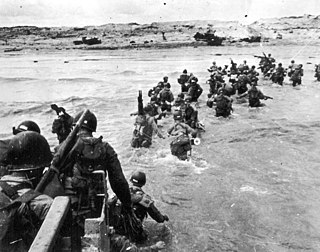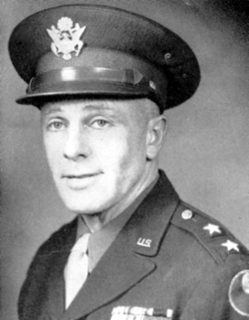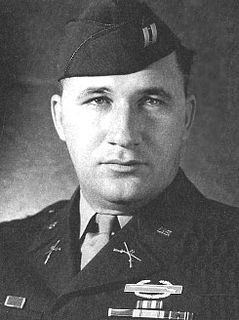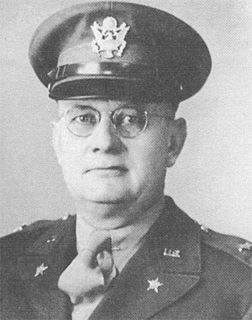
Omaha, commonly known as Omaha Beach, was the code name for one of the five sectors of the Allied invasion of German-occupied France in the Normandy landings on June 6, 1944, during World War II. "Omaha" refers to an 8-kilometer (5 mi) section of the coast of Normandy, France, facing the English Channel, from east of Sainte-Honorine-des-Pertes to west of Vierville-sur-Mer on the right bank of the Douve River estuary. Landings here were necessary to link the British landings to the east at Gold with the American landing to the west at Utah, thus providing a continuous lodgement on the Normandy coast of the Bay of the Seine. Taking Omaha was to be the responsibility of United States Army troops, with sea transport, mine sweeping, and a naval bombardment force provided predominantly by the United States Navy and Coast Guard, with contributions from the British, Canadian and Free French navies.

Utah, commonly known as Utah Beach, was the code name for one of the five sectors of the Allied invasion of German-occupied France in the Normandy landings on June 6, 1944 (D-Day), during World War II. The westernmost of the five code-named landing beaches in Normandy, Utah is on the Cotentin Peninsula, west of the mouths of the Douve and Vire rivers. Amphibious landings at Utah were undertaken by United States Army troops, with sea transport, mine sweeping, and a naval bombardment force provided by the United States Navy and Coast Guard as well as elements from the British, Dutch and other Allied navies.

Gold, commonly known as Gold Beach, was the code name for one of the five areas of the Allied invasion of German-occupied France in the Normandy landings on 6 June 1944, during the Second World War. Gold, the central of the five areas, was located between Port-en-Bessin on the west and La Rivière on the east. High cliffs at the western end of the zone meant that the landings took place on the flat section between Le Hamel and La Rivière, in the sectors code-named Jig and King. Taking Gold was to be the responsibility of the British Army, with sea transport, mine sweeping, and a naval bombardment force provided by the Royal Navy as well as elements from the Dutch, Polish and other Allied navies.

The 29th Infantry Division, also known as the "Blue and Gray Division", is an infantry division of the United States Army based in Fort Belvoir, Virginia. It is currently a formation of the U.S. Army National Guard and contains units from Virginia, Maryland, Kentucky, North Carolina, South Carolina and West Virginia.
The 164th Infantry Division was an infantry division of the German Army during World War II. Formed in November 1939, the division took part in the invasion of Greece in April 1941. In January 1942, consolidating the Axis seizure of the island during the Battle of Crete, the 164th was reorganized as Fortress Division Kreta (FDK). In mid-1942 the division was transferred to North Africa and re-designated as 164th Light Afrika Division. It surrendered in May 1943 in Tunisia at the end of the North African Campaign.

The Battle for Caen is the name given to fighting between the British Second Army and the German Panzergruppe West in the Second World War for control of the city of Caen and vicinity, during the larger Battle of Normandy. The battles followed Operation Neptune, the Allied landings on the French coast on 6 June 1944 (D-Day). Caen is about 9 mi (14 km) inland from the Calvados coast astride the Orne River and Caen Canal, at the junction of several roads and railways. The communication links made it an important operational objective for both sides. Caen and the area to the south is flatter and more open than the bocage country in western Normandy; Allied air force commanders wanted the area captured quickly to base more aircraft in France.
The 3rd Maryland Regiment was an infantry regiment of the Continental Army during the American Revolutionary War. It served from 1776 to 1783, mostly in the Middle Atlantic Region of the conflict.

Major General Charles Hunter Gerhardt was a senior United States Army officer who fought in both World War I and World War II. During the latter, he commanded the 29th Infantry Division from 1943 until the end of the war and during part of the occupation of Germany. The division's most famous combat operations were the Omaha Beach landings of June 6, 1944, otherwise known as D-Day, and the taking of the French crossroads town of Saint-Lô in July 1944. He reached the rank of major general.

Dietrich Kraiss was a German general during World War II. He was a recipient of the Knight's Cross of the Iron Cross with Oak Leaves of Nazi Germany.

The Battle for Brest was fought in August and September 1944 on the Western Front during World War II. Part of the overall Battle for Brittany and the Allied plan for the invasion of mainland Europe called for the capture of port facilities, in order to ensure the timely delivery of the enormous amount of war materiel required to supply the invading Allied forces. It was estimated that the 37 Allied divisions to be on the continent by September 1944 would need 26,000 tons of supplies each day. The main port the Allied forces hoped to seize and put into their service was Brest, in northwestern France.
George Van Horn Moseley Jr. a United States Army officer who served in World War II, and later served as commandant of cadets at Norwich University.

The 3rd Parachute Division was an elite military unit of Nazi Germany's Luftwaffe that was active during World War II. Its formation began in October 1943 in France near Reims. From February 1944 near Brest. In March 1944 division was reinforced by soldiers from the 3rd Battalion of the 1st Parachute Regiment.
USS Thurston (AP-77) was a troop transport that served with the United States Navy during World War II. She was named after counties in Nebraska and Washington.

The SCR-694 was a portable two way radio set used by the U.S. military during World War II.

Leonard Treherne "Max" Schroeder Jr. was a colonel in the United States Army, who served on active duty from 1941 to 1971. As a captain during World War II, he commanded Company F of the 2nd Battalion, 8th Infantry Regiment, 4th Infantry Division in the Normandy Landings on June 6, 1944, landing on Utah beach in France. Leading the men of his company, Schroeder was the first American soldier to come ashore from a landing craft in the D-Day invasion.
The following units and commanders participated in the Lorraine campaign from September 1 to December 18, 1944.

Brigadier General James Edward Wharton was a career United States Army officer who briefly commanded the 28th Infantry Division in the Battle of Normandy before being killed in action during World War II.
The Replacement Army was part of the Imperial German Army during World War I and part of the Wehrmacht during World War II. It was based within Germany proper and included command and administrative units as well as training and guard troops. Its primary role was to provide replacements for the combat divisions of the regular army.
The 347th Infantry Division was an infantry division of the German Army during the Second World War, active from 1942 to 1945. Initially based in the Netherlands, it saw active service on the Western Front and was redesignated as a Volksgrenadier division in May 1945.